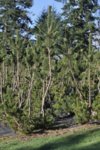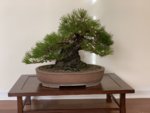tmjudd1
Mame
Yep. Too soon to be removing low branches! Low branches are gold!! GOLD!!!
Let's see if I'm starting to understand things, correctly, regarding trunk development and taper?
"If the low branches are 'GOLD'... does this mean that the next level of branches are 'silver'?"...
... and the 3rd level could be considered copper, etc. all the way up the trunk?
Basically, should I allow the lower branches and the sacrificial apex to run wild, while not allowing the 'other branches' to run quite so wild?
Please pardon the crude drawing below. If I'm understanding things, correctly, is this the way to properly develop thickness 'and' taper in JBP?
The brown is obviously the trunk and limbs. The green is to represent flushes of needles.
I drew this with bar branches for simplicity, however. I just started to wonder. If 'one' bar branch side were allowed to grow wilder than its opposing branch, would that create natural movement in the trunk, or just create a fatter branch and a 'lump' where it meets the trunk?

Last edited:




